#entry of jesus in jerusalem
Photo

Juli Borrell i Pla (Spanish, 1877 - 1957)
Entry of Jesus in Jerusalem, 1896
Museu Nacional D'art de Catalunya
#Juli Borrell i Pla#spanish art#spanish#european art#christian art#entry of jesus in jerusalem#art#arts#fine art#oil painting#christianity#christentum#Christendom#catholic#catholicism#Christ#Jesus Christ#The Son of God#Son of God#traditional art#europe#europa#european#Entry of Jesus in Jerusalem 1896
591 notes
·
View notes
Text
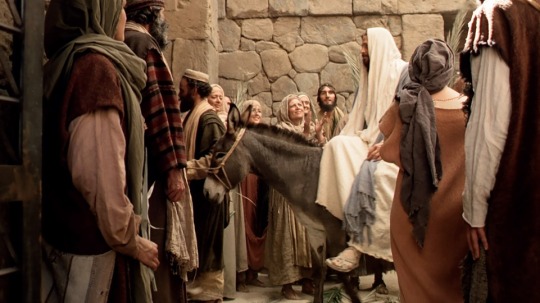
The Triumphal Entry
As they approached Jerusalem and came to Bethphage on the Mount of Olives, Jesus sent out two disciples, saying to them, “Go into the village ahead of you, and at once you will find a donkey tied there, with her colt beside her. Untie them and bring them to Me. If anyone questions you, tell him that the Lord needs them, and he will send them right away.”
This took place to fulfill what was spoken through the prophet:
“Say to the Daughter of Zion,
‘See, your King comes to you,
gentle and riding on a donkey,
on a colt, the foal of a donkey.’ ”
So the disciples went and did as Jesus had directed them. They brought the donkey and the colt and laid their cloaks on them, and Jesus sat on them.
A massive crowd spread their cloaks on the road, while others cut branches from the trees and spread them on the road.
The crowds that went ahead of Him and those that followed were shouting:
“Hosanna to the Son of David!”
“Blessed is He who comes in the name of the Lord!”
“Hosanna in the highest!”
When Jesus had entered Jerusalem, the whole city was stirred and asked, “Who is this?”
The crowds replied, “This is Jesus, the prophet from Nazareth in Galilee.”
Then Jesus entered the temple courts and drove out all who were buying and selling there. He overturned the tables of the money changers and the seats of those selling doves. And He declared to them, “It is written: ‘My house will be called a house of prayer.’ But you are making it ‘a den of robbers.’”
The blind and the lame came to Him at the temple, and He healed them. But the chief priests and scribes were indignant when they saw the wonders He performed and the children shouting in the temple courts, “Hosanna to the Son of David!”
“Do you hear what these children are saying?” they asked.
“Yes,” Jesus answered. “Have you never read:
‘From the mouths of children and infants
You have ordained praise’?”
Then He left them and went out of the city to Bethany, where He spent the night.
In the morning, as Jesus was returning to the city, He was hungry. Seeing a fig tree by the road, He went up to it but found nothing on it except leaves. “May you never bear fruit again!” He said. And immediately the tree withered.
When the disciples saw this, they marveled and asked, “How did the fig tree wither so quickly?”
“Truly I tell you,” Jesus replied, “if you have faith and do not doubt, not only will you do what was done to the fig tree, but even if you say to this mountain, ‘Be lifted up and thrown into the sea,’ it will happen. If you believe, you will receive whatever you ask for in prayer.”
When Jesus returned to the temple courts and began to teach, the chief priests and elders of the people came up to Him. “By what authority are You doing these things?” they asked. “And who gave You this authority?”
“I will also ask you one question,” Jesus replied, “and if you answer Me, I will tell you by what authority I am doing these things. What was the source of John’s baptism? Was it from heaven or from men?”
They deliberated among themselves and said, “If we say, ‘From heaven,’ He will ask, ‘Why then did you not believe him?’ But if we say, ‘From men,’ we are afraid of the people, for they all regard John as a prophet.” So they answered, “We do not know.”
And Jesus replied, “Neither will I tell you by what authority I am doing these things.
But what do you think? There was a man who had two sons. He went to the first one and said, ‘Son, go and work today in the vineyard.’
‘I will not,’ he replied. But later he changed his mind and went.
Then the man went to the second son and told him the same thing.
‘I will, sir,’ he said. But he did not go.
Which of the two did the will of his father?”
“The first,” they answered.
Jesus said to them, “Truly I tell you, the tax collectors and prostitutes are entering the kingdom of God before you. For John came to you in a righteous way and you did not believe him, but the tax collectors and prostitutes did. And even after you saw this, you did not repent and believe him.
Listen to another parable: There was a landowner who planted a vineyard. He put a wall around it, dug a winepress in it, and built a tower. Then he rented it out to some tenants and went away on a journey.
When the harvest time drew near, he sent his servants to the tenants to collect his share of the fruit. But the tenants seized his servants. They beat one, killed another, and stoned a third.
Again, he sent other servants, more than the first group. But the tenants did the same to them.
Finally, he sent his son to them. ‘They will respect my son,’ he said.
But when the tenants saw the son, they said to one another, ‘This is the heir. Come, let us kill him and take his inheritance.’ So they seized him and threw him out of the vineyard and killed him.
Therefore, when the owner of the vineyard returns, what will he do to those tenants?”
“He will bring those wretches to a wretched end,” they replied, “and will rent out the vineyard to other tenants who will give him his share of the fruit at harvest time.”
Jesus said to them, “Have you never read in the Scriptures:
‘The stone the builders rejected
has become the cornerstone.
This is from the Lord,
and it is marvelous in our eyes’?
Therefore I tell you that the kingdom of God will be taken away from you and given to a people who will produce its fruit. He who falls on this stone will be broken to pieces, but he on whom it falls will be crushed.”
When the chief priests and Pharisees heard His parables, they knew that Jesus was speaking about them. Although they wanted to arrest Him, they were afraid of the crowds, because the people regarded Him as a prophet.
— Matthew 21 | The Reader’s Bible (BRB)
The Reader’s Bible © 2020 by Bible Hub and Berean Bible. All rights Reserved.
Cross References: Genesis 4:24; Exodus 30:12; Genesis 49:11; Leviticus 1:14; Ruth 1:19; 2 Samuel 14:7; 2 Kings 9:13; Psalm 8:2; Psalm 118:22; Psalm 118:26; Proverbs 26:5; Song of Solomon 8:11; Isaiah 5:1-2; Isaiah 5:3; Isaiah 8:14; Isaiah 28:13; Isaiah 28:16; Isaiah 56:7; Isaiah 62:11; Jeremiah 7:11; Jeremiah 8:13; Jeremiah 26:8; Jeremiah 37:15; Matthew 4:28; Matthew 7:7; Matthew 8:10-11; Matthew 9:27; Matthew 11:9; Matthew 11:25; Matthew 13:3; Matthew 16:7; Matthew 17:20; Matthew 20:24; Matthew 20:34; Matthew 22:4; Matthew 26:6; Matthew 26:55; Mark 11:1; Mark 11:7-8; Mark 11:12; Mark 11:20; Mark 11:23; Mark 11:27; Mark 12:1-2; Luke 20:5; Luke 20:16; John 7:30; 1 John 3:22
#Jesus’ Triumphal Entry into Jerusalem#Jesus Cleanses the Temple#Jesus curses the fig tree#The Authority of Jesus Questioned#the Parable of the Two sons#The Parable of the Wicked Tenants#Matthew 21#Gospel of Matthew#New Testament#BRB#The Reader's Bible#Bible Hub#Berean Bible
2 notes
·
View notes
Text
24th March
Palm Sunday/ St Gabriel’s Day/ Purim

Christ’s Triumphal Entry into Jerusalem by Harry Anderson. Source: The Church of Jesus Christ of Latter Day Saints website.
In 2024, today is Palm Sunday. The day marks the start of Passion Week, the commemoration of Jesus Christ’s Passion and death. Palm Sunday represents when Jesus, in fulfilment of Biblical prophecy, rode into Jerusalem, seated on an ass, while the people greeted him by waving lengths of palms torn down from nearby trees to greet him. The event symbolised both Jesus’ humility (riding into the Jewish capital on such a lowly steed) but also his status as a liberator (cheered into the city by crowds waving palms - the sign of a conquering hero). In the U.K., where no palm trees go, the comemorative Palm Sunday Processions made do with alternative cuttings - pussy willow (the English Palm), yew, box, hazel, willow or daffodils. Such greenery in churches made the Puritan Protestants of the seventeenth century suspicious of the festival, sensing pagan roots, which may explain why Palm Sunday tends to be more significant to Roman Catholics than to Protestants. These days Spanish palms (somewhat dried out and yellow) are imported to be handed out at Palm Sunday masses and processions.
Today is also St Gabriel’s Day, the archangel who announced Mary’s conception to her and who, on the Final Day will fight the monstrous Leviathan and will defeat it.
In 2024, today is also the Jewish festival of Purim, which allegedly commemorates the escape of the Israelites from Egypt, but which seems to have more in common with spring festivals and joyous mischief than it does with religious observance. Jews will dress in outlandish clothes, feast, sing, make merry and drink much alcohol. Mock rabbis are even elected, tracing a direct link to the Lords of Misrule figures which had such a prominent roles in medieval Christmases.
#palm sunday#Jesus’ entry to Jerusalem#Palm Sunday processions#st Gabriel’s day#Leviathan#purim#passion week
1 note
·
View note
Text
SNAKE CHURCH
The Snake Church in the Göreme Open Air Museum has unique frescoes, including one of a snake. It features scenes from the Bible, such as Adam and Eve.
The Snake Church, also known as Yılanlı Kilise, is one of the most unique and distinctive cave churches in the Göreme Open Air Museum. It gets its name from the fresco on the wall of a coiled snake, which represents the “serpent of sin” from the Garden of Eden. The church is quite small, but it’s known for its intricate rock-carved decorations and columns. The frescoes inside depict various…

View On WordPress
#adam#CAPPADOCİA#christ#churches#depict#entry into jerusalem#eve#explorer#frescoes#HOTAİRBALLOon#kingdom of god#musum#nativity#presence of jesus#sinful
0 notes
Text
Sunday School Live Stream - May 28, 2023
https://www.facebook.com/akronalliancefellowship/videos/229783536429122
Sunday school session with Asst. Pastor Melvin Gaines.
John 12:12-19
View On WordPress
#coat#colt#disciple#donkey#foal#Hosanna#Jerusalem#Jesus#John#John 12#king#palm#Palm Sunday#Pharisee#triumph#triumphal entry#understand
0 notes
Text
"Behold the Lamb!"
I am not one to be easily amazed. But trust me, the picture painted in this PODCAST, courtesy of the biblical writers, is in every sense of the word… AMAZING!!!
Thank you for listening, and for sharing this message!!!
Please remember that depending upon your web browser and connection speed, it may take up to 60 seconds for this podcast to begin to play.
God bless you richly as you listen.

View On WordPress
#Christ#Easter#freedom#Good Friday#Holy week#Jerusalem#Jesus#Maundy Thursday#Palm Sunday#Passover#revolution#Triumphal Entry#tyranny
0 notes
Text
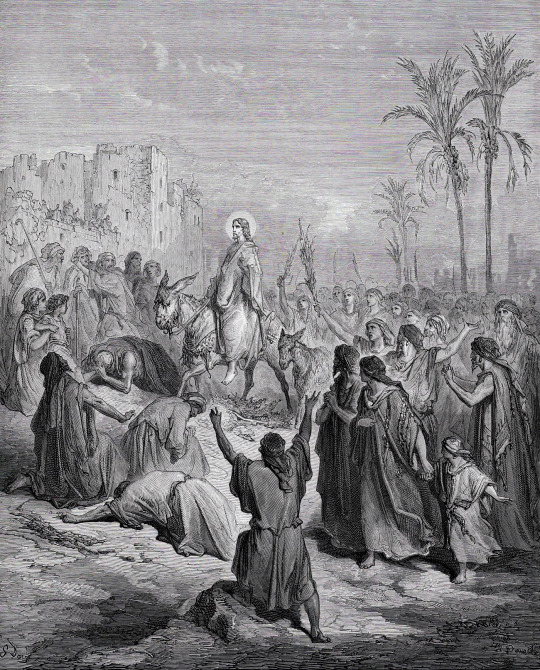
Entry of Jesus into Jerusalem by Gustave Doré
#jesus christ#jesus#christ#jerusalem#art#gustave doré#christianity#christian#la grande bible de tours#bible#biblical#religion#religious art#religious#donkey#donkeys#palm sunday#animals#palm branches#triumph#triumphal#triumphant#halo
432 notes
·
View notes
Text
To follow up on my Hosanna poll, I think before things go any further, it'd be good to actually explain and define it. I was initially going to wait until the end of the poll, but it seems that google is giving people a lot of bad and/or conflicting answers and I'd rather people walk away with the correct information.
So! Hosanna is an anglicized version of the Hebrew words "hosha na" [הושע נא or as a contraction הושענא]. Hosha na is a little enigmatic and hard to translate, but the simplest translation is probably "save us, please." It's traditionally used as an exclamation to G-d to rescue us, but it also has shades of being a triumphant shout (the implication being confidence that G-d will save us.)
Jews say "hoshanot" (the plural of hosha na) as part of our traditional Sukkot liturgy, and is something we do still today.
For us, the multi-faceted meaning of the root word allows us to have multiple layers of meaning. During Sukkot, we start praying for rain in its proper season and amounts, and we shake the lulav and etrog as part of these processions and liturgy. On Hoshana Rabba [the "great hoshana"], the last day of Sukkot, we process around the bimah (front lectern) seven times as a completion of our season of repentance and our starting of the new year with abundant blessings.
My siddur (prayer book) Lev Shalem has this as an explanation and translation:



[Image ID is of the Lev Shalem siddur, pages 382 & 383 - I tried hard to find a pdf of this that would be readable using a screen reader, but the versions I'm finding cut off at pg. 376 at the latest. If anyone has bandwidth to type this up, I would greatly appreciate it]
For the curious, here is a recording of the Hoshanot liturgy and procession:
youtube
Christians mostly know the word from the gospels and hymns.
Here is what Wikipedia says about its use in Christianity:
Historical meaning
Since those welcoming Jesus were Jewish, as of course Jesus himself was, some would interpret the cry of "Hosanna" on the entry of Jesus in its proper meaning, as a cry by the people for salvation and rescue.
Christian reinterpretation
"Hosanna" many interpret as a shout of praise or adoration made in recognition of the messiahship of Jesus on his entry into Jerusalem
It is applied in numerous verses of the New Testament, including "Hosanna! blessed is the one who comes in the name of the Lᴏʀᴅ!" (Matthew 21:9,15; Mark 11:9–10; John 12:13), which forms part of the Sanctus prayer; "hosanna in the highest" (Mark 11.10); and "hosanna to the Son of David" (Matt 21:9). These quotations, however, are of words in the Jewish Psalm 118. Although not used in the book of Luke, the testimony of Jesus' entry into Jerusalem is recorded in Luke 19.
In church music
The "Hosanna Anthem", based on the phrase Hosanna, is a traditional Moravian Church anthem written by Bishop Christian Gregor of Herrnhut sung on Palm Sunday and the first Sunday of Advent. It is antiphonal, i.e. a call-and-response song; traditionally, it is sung between the children and adult congregation, though it is not unheard of for it to be done in other ways, such as between choir and congregation, or played between trombone choirs.
The bottom line:
Jews and Christians have different connections, associations, and meanings attached to this word as expressions of our different theologies and texts. The word is derived from a Hebrew word and was created by Jews and is still used by us today. (Like literally today - we are currently in the middle of the Sukkot festival.) Christians changed the meaning to fit within their own context, and pronunciation of the word evolved with linguistic drift over time. In the same way that there's not a reason to pitch a fit over saying Jesus rather than Yeshua, there's no compelling reason to change hosanna back to hosha na; if anything, the distinction helps make it clear that it's effectively a different word and concept from ours.
On the other hand, I do think Christians ought to know the original meaning of the word if they're going to use it. To only ever know their version when it was derived from ours is yet another small way of playing into supercessionism by erasing and replacing the Jewish context of things that were originated in Judaism that Christians have embedded in Christianity. While the Christians of today cannot unwind the supercessionism of Christian history, they *can* choose to understand their present Christianity in ways that do not play into supercessionism and that respect the Jewish community of today.
I hope this was helpful and gives folks a new perspective on an obscure Hebrew word!
472 notes
·
View notes
Text
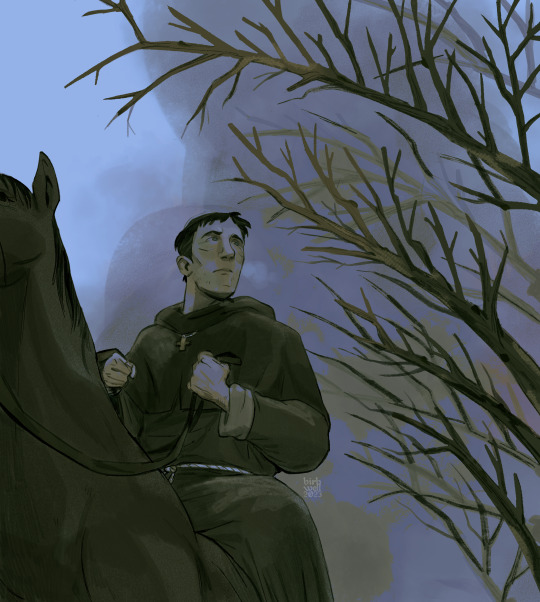
New Year's Day, 1136
last piece of the year. i wanted to flip the imagery of Jesus being greeted with palm fronds upon entry to Jerusalem. Philip being unwelcome & a sort of harbinger of not victory but doom for Kingsbridge. waves hand
philip closeup o7
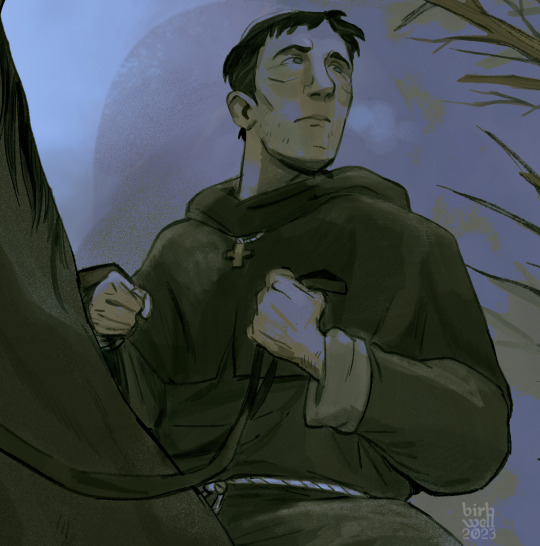
208 notes
·
View notes
Text
The Altar of Eccles Cakes
(updated 21 Oct 2023, for Grain Offerings example)
(updated 21 Nov 2023, for link to First Temptation)
The mysterious plate of Eccles cakes. Are they really to "calm people down?' And why do they just ...disappear? They must be there for a reason?
Yes, they certainly are. They are just the first course of a fascinating meal on offer in S2.
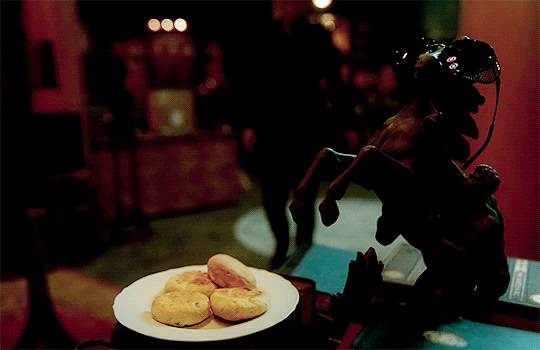
So far, most of the meta around the Eccles cakes has focused on the meaning of their name. Eccles is an old name for church. We could view it as Aziraphale trying to calm Crowley down. They are also known as "squashed fly cakes." The white outside and the black inside could be seen as a metaphor relating to Gabriel. Or it hints at the Roger the Stunt Fly, that contain Gabriel's memories, flying around the book shop, who's purpose we don't find out about until the end. There is even a link to the 1650 Sorry Dance that Aziraphale mentioned, in that were banned by Oliver Cromwell for being pagan! (Did I get that right? I've not kept the post link.)
[Edit: They also represent the First Temptation as Jesus fasts in the wilderness for 40 days before the Entry into Jerusalem at the start of the Passion narratives, where bread was made from stones.]
Take another look at the blocking in this shot. The dark horse statue, representing Crowley - even wearing his sunglasses! - has the placating plate of Eccles cakes placed before it, in supplication. Yeah, it didn't work this time, but it's the thought that counts. What we have here is Aziraphale making an Sin offering to the altar of Crowley, to ask for atonement in advance for what he has done (taking Gabriel in.)
Once you frame it in that reference, you realize its not the only altar offering made during S2. It also adds a bit more depth to some of the other scenes, where they have all been mentioned already in some way, but it certainly helps to explain the Eccles cakes!
Firstly, we need to mention the main types of altar offering that are made:
Burnt offerings - for general atonement of sins and for expression of devotion to God. It could be a bull, a ram, goat, or a bird in the form of a dove or pigeon. Such as this magnificent example in the Job minisode.

Aziraphale certainly devoted himself to the sin of gluttony on that occasion. (hang on, that didn't come out the right way, did it...?) But he was still devoted to God, despite his nocturnal conversation with Crowley while they waited out the storm in the cellar.
Grain offerings - a voluntary expression of devotion to God. This was grain prepared in different way, but always seasoned, unsweetened and unleavened. Recall at Gomorrah Lot offered to prepare the visiting angels unleavened bread as part of a meal.
Originally when I wrote this post I didn't think I had any Grain offering examples, but a few days later as I was writing my post on The Ineffable Ducks I realized where the missing S2 Grain offering was - in S2E1, when Crowley yells at the Azerbaijani spies in St James Park. The ducks are usually offered bread, which is leavened with yeast, so technically not quite correct, but when you review all the instances of feeding the ducks crumbs or bread crumbs it certainly fits. Unless you are Crowley, and you'd rather have the current state of quiet "frozen peas" between Heaven and Hell. See my Ineffable Ducks post for an elaboration.

Peace offering - This could be cattle, sheep or goat without defect, but the main purpose to was consecrate a meal between two or more parties before God and share that meal in a fellowship of peace and commitment to each other's future prosperity.
You know where we see one of these? At the eldritch ball!

I did see a nice meta about the vol-au-vents recently, mainly about their name, but I don't seem to have saved it, and can't find it again. They are usually filled with chicken (a bird) and the eldritch ball is ostensibly the shopkeepers monthly meeting, after all, where they are there to talk about their mutual prosperity in the future. Just so happens its also an opportunity for Aziraphale to talk to Crowley about their future...oh, and Nina and Maggie's, as well, of course!
Sin offering - atonement or unintentional sin. It would have the elements of a Burnt offering, as well as a Peace offering, but not be shared. These are what the plate of Eccles cakes are, so they were never meant to be eaten. They were an olive branch to Crowley regarding Gabriel, but he turned it down. So they softly and suddenly vanish away, never to be met with again.*
There is one more altar offering that needs to mentioned, another Sin offering. The one Crowley consumed in Elspeth's place in The Resurrectionists minisode in 1832 Edinburgh - the laudanum.

It pretty clear to most observers that Crowley did a good and "kind deed" for Elspeth here, which angered Hell in the process and then he was dragged forcibly downstairs to be duly punished for it. There is a post here from atlas-hope that suggests this is a parallel of Jesus in the Garden of Gethsemane, drinking the cup of God's wrath to absolve Christians of their sins. They point out the laudanum is even poured into a goblet. Crumbs, that's a hefty bit of spiritual lifting, dear demon. What were you thinking, Anthony J. Crowley? It might cast that conversation you had with the carpenter back on the mountain in a new light, or least make us look back twice at it. (Plenty of time for contemplation before S3 arrives...)
Remember, a Sin offering has elements of both a Burnt offering and a Peace offering: a giant Crowley gets Elspeth to promise to devote the rest of her life to being "properly good, not just pretendy good" and the money Aziraphale is forced to donate to her ensures her future prosperity. Sounds like a win-win situation there, Elspeth!
[*OK, if you don't get the ref, its from the Hunting of the Snark. The Snark represents happiness, a most elusive thing to find, and more often than not its a fruitless search, and you find the terrible Boojum instead. During the third verse the Baker recounts the lecture his uncle gives him about how to hunt the Snark, and to be aware of his fate if he is unlucky enough to encounter a Boojum. It kind of fits in with S2, I feel.]
#good omens#good omens 2#good omens meta#aziraphale#crowley#a companion to owls#the resurrectionists#job minisode#elspeth#laudanum#constitution of an ox#crucifixion pose crowley#altar offerings#Fit the Third: The Baker's Tale#Eccles Cakes#I'm sure the Baker would have baked a few Eccles cakes in his time before he embarked
94 notes
·
View notes
Text

-Entry Of Jesus Into Jerusalem-
49 notes
·
View notes
Text
John 7:40-52
Nicodemus challenged his fellow pharisees.
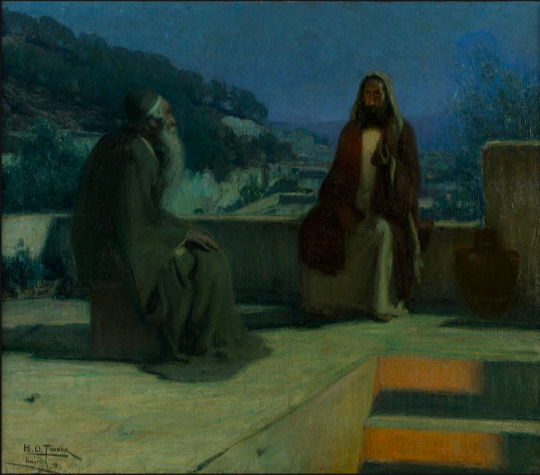
Nicodemus Visiting Jesus,
Painting by Henry Ossawa Tanner (1859-1957),
Painted in 1899,
Oil on canvas
© Pennsylvania Academy of Fine Arts
Gospel Reading
Several people who had been listening to Jesus said, ‘Surely he must be the prophet’, and some said, ‘He is the Christ’, but others said, ‘Would the Christ be from Galilee? Does not scripture say that the Christ must be descended from David and come from the town of Bethlehem?’ So the people could not agree about him. Some would have liked to arrest him, but no one actually laid hands on him.
The police went back to the chief priests and Pharisees who said to them, ‘Why haven’t you brought him?’ The police replied, ‘There has never been anybody who has spoken like him.’ ‘So’ the Pharisees answered ‘you have been led astray as well? Have any of the authorities believed in him? Any of the Pharisees? This rabble knows nothing about the Law – they are damned.’ One of them, Nicodemus – the same man who had come to Jesus earlier – said to them, ‘But surely the Law does not allow us to pass judgement on a man without giving him a hearing and discovering what he is about?’ To this they answered, ‘Are you a Galilean too? Go into the matter, and see for yourself: prophets do not come out of Galilee.’
Reflection on the painting
In today's Gospel reading, we encounter Nicodemus, marking his second of three appearances in the Gospel of John. Initially introduced as a curious seeker who approaches Jesus under the cover of night, Nicodemus is portrayed as intrigued by Jesus yet hesitant to fully embrace his teachings. His journey of faith is subtly woven through John's narrative, culminating in his participation alongside Joseph of Arimathea in ensuring Jesus receives a respectful (indeed, lavish) burial. This progression illustrates Nicodemus's gradual movement towards a deeper understanding and commitment to Jesus. Our reading today is the second (and middle) appearance of Nicodemus. Despite being a Pharisee, he displays remarkable bravery by questioning the outright dismissal of Jesus by his peers, who criticize Jesus based on his origin in Galilee, a region they regard as insignificant compared to the religious hub of Jerusalem. Nicodemus advocates for fairness and due process, arguing that Jesus should not be judged without first being heard. This stance places him at odds with the prevailing opinions of his colleagues, and his challenge is met with scorn, evidenced by their sarcastic comment "Are you from Galilee too?"
Nicodemus's growing relationship with Jesus left him increasingly isolated in the world where he had been so much at home. He actually reminds us that as we grow in our relationship with Jesus, there is often a price to be paid. We may find ourselves a lone voice among our peers. At such times, we know that the Lord is always with us.
Henry Ossawa Tanner painted our canvas in 1899, depicting the first of the three mentions of Nicodemus in John's Gospel (John 3:1-21). The painting was Tanner's entry to the 1899 Paris Salon. We see Nicodemus talking privately to Christ in the evening, a good example of Tanner's nocturnal light paintings. The painting was purchased there for the Wilstadt Collection, Philadelphia, and is now in the Pennsylvania Academy of Fine Arts. The narrative of Nicodemus' meeting with Jesus held significant meaning for Henry Ossawa Tanner's father, Benjamin Tucker Tanner. He was a Bishop in the African Methodist Episcopal Church and had aspirations for his son to join him in the ministry. While Henry's decision to pursue a career as an artist fell short of his father's dream, his talent for painting ultimately produced works that his father could admire and support.
Article by Father Patrick van der Vorst
#christian blog#jesus#bible reading#christian doctrine#bible scripture#biblical#glorytogod#bible#faith in jesus#bible study#modern art#artwork#art history#old art#religious art#bible reflection#art#artists#history#share the gospel#gospel#word of god#kingdom of heaven#christian faith#follow jesus#bible verse#biblical art#spiritual disciplines#spiritual warfare#walk with god
20 notes
·
View notes
Text
Live Stream Sunday School - May 28, 2023
https://www.facebook.com/gaines.melvin/videos/273192448429183
Sunday school session for Akron Alliance Fellowship Church, Akron OH.
John 12:12-19
View On WordPress
#coat#colt#disciple#donkey#foal#Hosanna#Jerusalem#Jesus#John#John 12#king#palm#Palm Sunday#Pharisee#triumph#triumphal entry#understand
0 notes
Text
Saints &Reading: Wednesday, February 21, 2024
february 8_february 21
E PROPHET ZECHARIAH (ZAKHARIAH) THE SICKLE-SEER FROM AMONGST THE 12MINOR PROPHETS (520 BC)

The Prophet Zachariah the Sickle-Seer the eleventh of the twelve Minor Prophets. He was descended from the tribe of Levi, and seems to have been a priest (Nehemiah 12:4,16). He was called to prophetic service at a young age and became, in the wondrous expression of church hymnology, “a spectator of supra-worldly visions.”
The Book of the Prophet Zachariah contains inspired details about the coming of the Messiah (Zach 6:12); about the last days of the Savior’s earthly life, about the Entry of the Lord into Jerusalem on a young donkey (Zach 9:9); about the betrayal of the Lord for thirty pieces of silver and the purchase of the potter’s field with them (Zach 11:12-13); about the piercing of the Savior’s side (Zach 12:10); about the scattering of the apostles from the Garden of Gethsemane (Zach 13:7); about the eclipse of the sun at the time of the Crucifixion (Zach 14:6-7).
“Enlightened by dawnings all above,” the Prophet Zachariah, “saw the future as it were the present.” According to Tradition, this “most true God-proclaimer” lived to old age and was buried near Jerusalem, beside his illustrious contemporary and companion, the Prophet Haggai (December 16). The title “Sickle-Seer” given Zachariah comes from a vision in which he saw a sickle flying in the air, destroying thieves and perjurors (Zach 5:1-3).
The holy Prophet Zachariah died around 520 B.C. His tomb was discovered in 415 in a village near Eleutheropolis (Sozomen, Hist. Eccles. VI:32, IX:17). At the prophet’s feet was the body of a child dressed in royal accouterments. His holy relics were transferred to the church of Saint James the Brother of the Lord (October 23) in Constantinople.

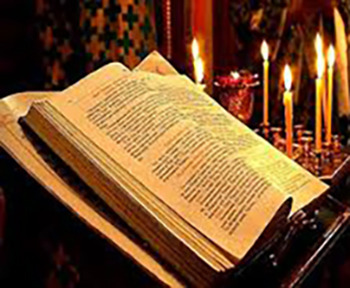
1 PETER 4:1-11
1Therefore, since Christ suffered for us in the flesh, arm yourselves also with the same mind, for he who has suffered in the flesh has ceased from sin, 2 that he no longer should live the rest of his time in the flesh for the lusts of men, but for the will of God. 3 For we have spent enough of our past lifetime in doing the will of the Gentiles-when we walked in lewdness, lusts, drunkenness, revelries, drinking parties, and abominable idolatries. 4 In regard to these, they think it strange that you do not run with them in the same flood of dissipation, speaking evil of you. 5 They will give an account to Him who is ready to judge the living and the dead. 6For this reason the gospel was preached also to those who are dead, that they might be judged according to men in the flesh, but live according to God in the spirit. 7 But the end of all things is at hand; therefore be serious and watchful in your prayers. 8 And above all things have fervent love for one another, for "love will cover a multitude of sins." 9 Be hospitable to one another without grumbling.10 As each one has received a gift, minister it to one another, as good stewards of the manifold grace of God. 11 If anyone speaks, let him speak as the oracles of God. If anyone ministers, let him do it as with the ability which God supplies, that in all things God may be glorified through Jesus Christ, to whom belong the glory and the dominion forever and ever. Amen.
MARK 12:28-37
28 Then one of the scribes came, and having heard them reasoning together, perceiving that He had answered them well, asked Him, "Which is the first commandment of all?" 29 Jesus answered him, "The first of all the commandments is: 'Hear, O Israel, the LORD our God, the LORD is one. 30 'And you shall love the LORD your God with all your heart, with all your soul, with all your mind, and with all your strength.' This is the first commandment. 31 And the second, like it, is this: 'You shall love your neighbor as yourself.' There is no other commandment greater than these. 32 So the scribe said to Him, "Well said, Teacher. You have spoken the truth, for there is one God, and there is no other but He. 33 And to love Him with all the heart, with all the understanding, with all the soul, and with all the strength, and to love one's neighbor as oneself, is more than all the whole burnt offerings and sacrifices. 34 Now when Jesus saw that he answered wisely, He said to him, "You are not far from the kingdom of God." But after that no one dared question Him. 35 Then Jesus answered and said, while He taught in the temple, "How is it that the scribes say that the Christ is the Son of David? 36 For David himself said by the Holy Spirit:'The LORD said to my Lord, Sit at My right hand, Till I make Your enemies Your footstool." ' 37 Therefore David himself calls Him 'Lord'; how is He then his Son? And the common people heard Him gladly.
#orthodoxy#orthodoxchristianity#easternorthodoxchurch#originofchristianity#spirituality#holyscriptures#gospel#bible#wisdom#saints
10 notes
·
View notes
Text

The Raising of Lazarus (Lazarus Saturday)
Commemorated on April 27
By raising Lazarus from the dead before Your passion, You did confirm the universal Resurrection, O Christ God! Like the children with the palms of victory, we cry out to You, O Vanquisher of death: Hosanna in the Highest! Blessed is He that comes in the Name of the Lord!
In a carefully detailed narrative the Gospel relates how Christ, six days before His own death, and with particular mindfulness of the people “standing by, that they may believe that thou didst send me” (John 11:42), went to His dead friend Lazarus at Bethany outside of Jerusalem. He was aware of the approaching death of Lazarus but deliberately delayed His coming, saying to His disciples at the news of His friend’s death: “For your sake I am glad that I was not there, so that you may believe” (John 11:14).
When Jesus arrived at Bethany, Lazarus was already dead four days. This fact is repeatedly emphasized by the Gospel narrative and the liturgical hymns of the feast. The four-day burial underscores the horrible reality of death. Man, created by God in His own image and likeness, is a spiritual-material being, a unity of soul and body. Death is destruction; it is the separation of soul and body. The soul without the body is a ghost, as one Orthodox theologian puts it, and the body without the soul is a decaying corpse. “I weep and I wail, when I think upon death, and behold our beauty, fashioned after the image of God, lying in the tomb dishonored, disfigured, bereft of form.” This is a hymn of Saint John of Damascus sung at the Church’s burial services. This “mystery” of death is the inevitable fate of man fallen from God and blinded by his own prideful pursuits.
With epic simplicity the Gospel records that, on coming to the scene of the horrible end of His friend, “Jesus wept” (John 11:35). At this moment Lazarus, the friend of Christ, stands for all men, and Bethany is the mystical center of the world. Jesus wept as He saw the “very good” creation and its king, man, “made through Him” (John 1:3) to be filled with joy, life and light, now a burial ground in which man is sealed up in a tomb outside the city, removed from the fullness of life for which he was created, and decomposing in darkness, despair and death. Again as the Gospel says, the people were hesitant to open the tomb, for “by this time there will be an odor, for he has been dead four days” (John 11:39).
When the stone was removed from the tomb, Jesus prayed to His Father and then cried with a loud voice: “Lazarus, come out.” The icon of the feast shows the particular moment when Lazarus appears at the entrance to the tomb. He is still wrapped in his grave clothes and his friends, who are holding their noses because of the stench of his decaying body, must unwrap him. In everything stress is laid on the audible, the visible and the tangible. Christ presents the world with this observable fact: on the eve of His own suffering and death He raises a man dead four days! The people were astonished. Many immediately believed on Jesus and a great crowd began to assemble around Him as the news of the raising of Lazarus spread. The regal entry into Jerusalem followed.
Lazarus Saturday is a unique day: on a Saturday a Matins and Divine Liturgy bearing the basic marks of festal, resurrectional services, normally proper to Sundays, are celebrated. Even the baptismal hymn is sung at the Liturgy instead of Holy God: “As many as have been baptized into Christ, have put on Christ.”
Very Rev. Paul Lazor
Christ the Joy, the Truth and the Light of all, the Life of the World and the Resurrection has appeared in His goodness, to those on earth. He has become the Image of our Resurrection, granting divine forgiveness to all!
6 notes
·
View notes
Text


King Marcus and Queen Catalina were photographed entering the Glimmerbrook Cathedral to attend the Palm Sunday service ahead of the Easter Holiday. ♥️
This event is part of the annual Christian tradition that commemorates Jesus Christ's entry into Jerusalem before his crucifixion. The attendance of Their Majesties highlights the importance of the holiday to the royal family and the Christian Kingdom of Oasis Springs.✨
#sims 4 royal family#sims 4 royal legacy#sims 4 royal story#simblr#sims 4 royal simblr#sims 4 royalty#royal news#sims 4 gameplay#royal sims 4#royal simblr
8 notes
·
View notes